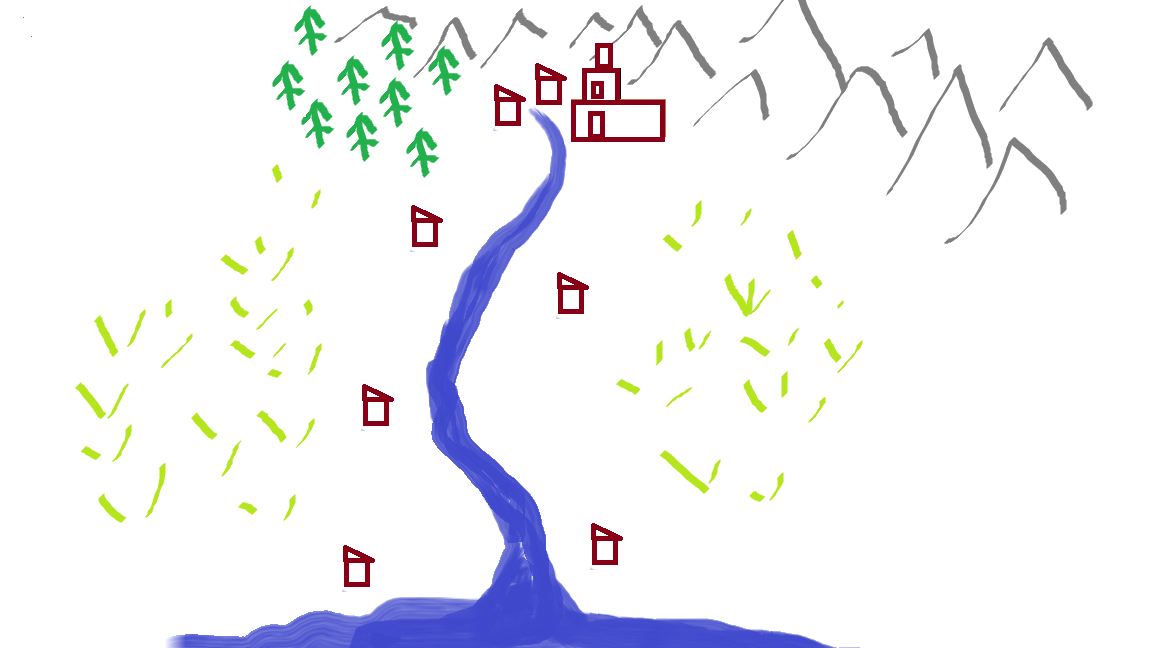In my first post on worldbuilding I discussed deciding the type of fantasy book you want to write and using that to define the nature of your world. The next step is to think about the country or countries in that fantasy world.
You may be able to get away with one country or you may need more. It depends on the direction your fantasy will take. Anything with a quest, or any high fantasy revolving around power struggles and war, will need multiple countries. Urban fantasies or sword and sorcery fantasies, which tend to be more character based, may only need one country to start with. They may indeed only need to focus on one city or village within that country, and then details of countries can be filled in later as they become relevant to the plot.
Terrain and climate
The terrain and climate you choose for your countries should not be arbitrary. Most fantasy books do stick to the general idea that northern countries are cold, often mountainous or forest covered. Likewise, southern countries are often hot and dry with desert terrain or hot and wet with tropical terrain. Clearly, one doesn’t have to keep to these climates, but they would immediately be identifiable to the reader without further need for explanation.
Whatever terrain you choose, it must be consistent within general geographic understanding unless there is a specific reason. A snow-covered jungle, for example, would not be perceived as as a natural habitat.
It may seem boring to stick to standard, sensible terrain, but this is the backdrop of our novel. It needs to form a natural background. Defining features of the terrain can always be added at a later date if needed. Consider this set-up to be like doing a wash on a watercolour painting.
Boundaries
Country boundaries can be formed in various ways. Terrain can determine countries. For example, a desert or forest may mark a boundary, or a tract of inhospitable land such as a marsh or wilderness. Countries will claim ownership of these types of land but they will be largely uninhabited, or inhabited by specific races–often unsociable ones.
Another form of boundary is political. Past wars can determine where the current land boundaries fall. Neighbouring kingdoms may dispute these boundaries, giving you an immediate source of conflict. You may need outposts along your boundary to guard your territory.
Population
The human population, assuming you have one, will probably congregate in villages, towns and cities. There are likely to be larger cities close to valuable resources, such as rivers and fertile land. Smaller towns will probably be situated at suitable intervals from the larger cities, and likewise, villages around the towns. This will spread outwards to the boundaries of the land where you may have small settlements or outposts.
Geographical features such as mountain ranges or forest may naturally dictate the best positions for human civilisation. You may well have other races in your fantasy land which require a different habitat. For example, your elves may have a city in the middle of the forest.
The Sketch
In my case study world, I have now chosen to work in a traditional mediaeval fantasy setting with characters such as witches, wizards, dragons, fairies and princesses. I prefer character based fantasy as opposed to epic, and so I will be creating one country to start with. I want a country with diverse geographical features and different sizes of towns and villages to ensure I have a variety of backdrops for the short stories I intend to create.
It’s a good idea at this stage to draw a very rough map of your country for your own personal reference. This doesn’t have to be anything fancy – a scribble on paper or a rough sketch on a computer programme like Paint will suffice.
This doesn’t have to be perfect at this stage. You only need a rough idea of where you are going. This is very much a work in progress to get your mind in the right place. With this in mind, I have drafted the following rough sketch of my, as yet, unnamed country:
I have a river running from the mountains, flowing into the sea. The capital city, with a castle, is nestled at the base of the mountains, close to the river, and not too far from the forest. This will ensure the city has the resources it needs in terms of fuel and water. Small towns are placed at intervals down the river. Farmland extends out from the river.
The dragons will live in the mountains where there will be plenty of caves for them. I haven’t decided about the fairies yet, but they can be placed anywhere. My castle will have a princess.
The climate will be temperate on the farmland and plains, and colder as you get closer to the mountains and forest.
For now, this is enough information to give me an idea of the country in which I want my stories to take place. Stay tuned for the next installment!


Great article. I like your map! Always good to visualise things. I have never been much of a world builder because my fantasy is usually fairly realistic, but lately I’ve been contemplating a lot about my novel’s setting.
Definitely agree with visualising things being helpful. I find the process of worldbuilding helps me to immerse myself in my story!
This makes me want to draw a map, for sure.
Pingback: Worldbuilding: Names | Magic Writer